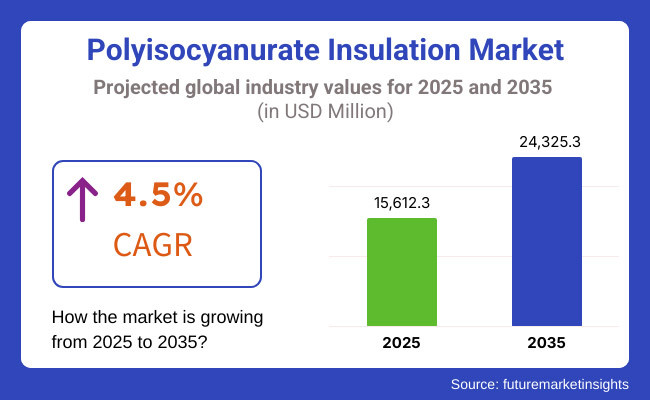Future Market Insights envisages that the demand for polyisocyanurate insulation is projected to expand at robust CAGR of 6.1% in terms of value during the forecast period, 2022-2028. Moreover, the valuation of polyisocyanurate insulation is forecast to reach US$ 19,030.6 Mn by the end of 2028, as per the report. Growing awareness and importance of energy saving is the key driver, positively impacting the growth of polyisocyanurate insulation market.
| Base Year Value (2021A) | US$ 12,510.0 Mn |
| Estimated Year Value (2022E) | US$ 13,295.5 Mn |
| Projected Year Value (2028F) | US$ 19,030.6 Mn |
| Value CAGR (2022-2028) | 6.1% |
| Collective Value Share: Top 3 Countries (2022E) | 27.8% |
With changing global scenario in terms of energy saving initiatives, innovations and advancements in in insulation technology, the global polyisocyanurate insulation market is likely to undergo major changes major changes in the coming years. Growing building and construction industry is expected to create positive impact on the growth of polyisocyanurate insulation market.
Rigid foam/board type insulation is expected to dominate the North America polyisocyanurate insulation market and spray type is likely to gain traction owing to its easy processability and application in wall assemblies. Growth in North America will mostly be driven by innovative product development and adoption of new regulations.
Request a sample to obtain authentic analysis and comprehensive market insights at- https://www.futuremarketinsights.com/reports/sample/rep-gb-6164
Diverse Benefits Making Polyisocyanurate Insulation Popular in Commercial and Residential Construction Markets
Application of polyisocyanurate insulation includes cold storage warehouses, private offices, medical buildings, airports and other industries that requires insulation materials.
Consumers are increasingly adopting sources for energy-efficient outcomes and moving towards sustainability, further driving the adoption of polyisocyanurate insulation materials across industry verticals. Considered stable for a wide range of temperature, builders are increasingly using light weighted polyisocyanurate insulation materials for conventional roof and wall assemblies.
Most importantly, sales of polyisocyanurate insulation materials is significantly rising considering key environment friendly aspects such as being CFC, HCFC, HFC free blowing agent along with zero ozone depletion potential.
Polyisocyanurate insulation is used in over 70% of commercial and residential markets for both wall and roof applications. The construction industry is under immense pressure to achieve increasing levels of energy performance and minimize environmental impact associated with increased energy consumption.
Intensifying Demand for Efficient Cold Chain Operations to Fuel Polyisocyanurate Insulation Sales
Close to US$ 750 Bn worth of food being wasted or lost, each year is putting global trade agencies in a tough spot. Since, most of these losses stem from poor supply cold chain networks along with lack of trained personnel involved in storage and transportation, significant demand for refrigerated trucks and carriers with efficient insulation is anticipated to drive the polyisocyanurate insulation adoption.
Global trade associations and organizations are focusing on developing a robust global cold chain network through improved regulatory framework, encouraging investment in development of efficient cold chain networks, utilizing polyisocyanurate insulation material in the refrigerated freight services market.
Sales of Eco-Friendly, Energy Saving Polyisocyanurate Insulation Products Anticipated to Augment Through 2028
Recyclable and in accordance with new insulation standards, polyisocyanurate insulation possesses practically no global warming potential and zero ozone depletion potential, making it a widely used eco-friendly insulation material, with highly attractive growth prospects in the coming years. Moreover, an array of initiatives have been taken up by Governments, in a bid to reduce CO2 emissions.
Growing public awareness apropos of climate change has proliferated the need for renewable energy systems and energy waste reduction initiatives. This increasing public awareness has also resulted in immense opportunities for manufacturers to develop high-performance insulation products. Using polyisocyanurate insulation would contribute directly to the initiatives associated with energy conservation, eventually mitigating the effects of global warming.
Innovative product development to improve efficacy, expansion of production capacity to cater to the growing demand for polyisocyanurate insulation in niche applications, and other feasibility studies coupled with strengthening distribution network to maintain the adequate supply of polyisocyanurate insulation are some key strategies adopted by top players to solidify their positions in the market.
Discover more about report analysis with figures and data tables, along with the table of contents. Ask an Analyst- https://www.futuremarketinsights.com/ask-question/rep-gb-6164
Polyisocyanurate Insulation Market by Category
By Type :
- Liquid
- Spray
- Rigid Foam/ Board
By Application :
- Acoustic
- Thermal
- Hybrid
By End Use :
- Building & Construction
- Roofs
- Walls
- Walls
- Transport
- Consumer Appliances
- Others
Key Questions Answered in the Report
What is the current size of the global business of Polyisocyanurate Insulation?
What is the consumption outlook of Polyisocyanurate Insulation in the Global market?
Which product type is expected to witness a significant growth rate in the industry of ferric sulphate and polyferric sulphate?
Who are the top players in the Global Market of Polyisocyanurate Insulation and what is their total share?
What is the market outlook of Polyisocyanurate Insulation of China?
Table Of Content
1. Executive Summary
1.1. Market Overview
1.2. Market Analysis
1.3. Analysis and Recommendations
1.4. Wheel of Fortune
2. Market Introduction
2.1. Market Definition
2.2. Market Taxonomy
3. Market Dynamics
3.1. Porter’s Analysis
3.2. Market Dynamics
3.2.1. Drivers
3.2.2. Restraints
3.2.3. Trend
4. Market Background
4.1. Macroeconomic Factors
4.2. Forecast Factors and Relevance Impact
4.3. Value Chain
5. Polyisocyanurate Insulation Market Scenario
5.1. Market Volume Analysis
5.2. Pricing Analysis
5.3. Market Size (US$) and Forecast
5.3.1. Market Value (US$ Mn) and Volume
5.3.2. Absolute $ Opportunity
6. Global Polyisocyanurate Insulation Market Analysis By Type
more…
Related Links:
https://spooool.ie/2022/04/11/phosphate-conversion-coatings-market-size-2022-global-key-findings-industry-demand-regional-analysis-key-players-profiles-future-prospects-and-forecasts-to-2028/
https://spooool.ie/2022/04/11/magnesium-chloride-market-outlook-2021-pricing-strategy-industry-latest-news-top-company-analysis-research-report-analysis-and-share-by-forecast-to-2031/
https://spooool.ie/2022/04/11/oem-insulation-market-size-2022-global-key-findings-industry-demand-regional-analysis-key-players-profiles-future-prospects-and-forecasts-to-2028/
https://spooool.ie/2022/04/11/epoxy-curing-agents-market-2022-by-global-key-players-types-applications-countries-industry-size-and-forecast-to-2028/
Contact Us:
Future Market Insights
Unit No: 1602-006
Jumeirah Bay 2
Plot No: JLT-PH2-X2A
Jumeirah Lakes Towers
Dubai
United Arab Emirates
LinkedIn| Twitter| Blogs
